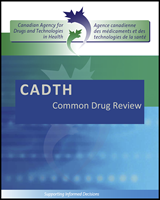This section was summarized by CDR staff based on the input provided by patient groups. It has not been systematically reviewed. It has been reviewed by the submitting patient groups.
1. Brief Description of Patient Group(s) Supplying Input
One patient group, Headache Network Canada (HNC), provided input. HNC is a Canadian registered charity whose mandate is to provide educational services to the headache sufferer and his/her family; raise the awareness level among the general public of the nature and impact of headache disorders; assist the medical profession and other health disciplines in the management of headache disorders; co-operate and work with governments at all levels to advance knowledge about all aspects of headache disorders and to encourage governmental assistance in this field; and to maintain and operate an educational website on the subject of headache disorders.
HNC receives unrestricted educational grants from Glaxo, Allergan, Tribute, Pfizer, Janssen, and Merck. HNC declared no conflict of interest in the preparation of the submission.
2. Condition and Current Therapy-related Information
Information to complete this section was gathered from various sources, including a survey distributed to the members of HNC (150 persons), to attendees at educational seminars and public forums (88 persons), and to caregivers (23 responses). Individual conversations took place with patients who had or had not previously used Botox.
CM is defined as follows: having a migraine headache on at least 15 days per month; on eight or more of these “migraine headache days,” having one-sided throbbing that is moderate or severe and that is aggravated by physical activity; and, at least one of nausea and/or vomiting, sensitivity to light, and/or sensitivity to sound.
Patients with CM are stigmatized by society, and even by family and friends at times. They often report that their lives are "ruined" by headaches that are "almost always" there. The pain interrupts every facet of their enjoyment of life. Along with the physical symptoms, sufferers report difficulty with mentally challenging tasks, feelings of hopelessness and helplessness, guilt, stress, and depression. Some people are forced to curtail schooling, employment, or having a family. They report having to cancel work and social and family activities and obligations when symptoms are severe. Furthermore, the unpredictability of attacks creates a natural resistance to committing to events, whether the events are personal, social, or vocational. When they are able to access partial relief or are experiencing a mild attack, they may be able to press on, but they underachieve, a condition coined "presenteeism."
Caregivers and loved ones report that living with or caring for someone with CM takes a lot of patience. It is an "invisible" disease. It is much easier to have sympathy for someone with a broken arm in a cast. CM is neither diagnosed by a blood test, nor does it show up on a radiographic image. People with migraine and their caregivers tell us they avoid making plans in case they have to cancel. They avoid hosting get-togethers, and fear the unpredictable nature of the attacks.
Patients report using medications that have not been approved for use in migraines. They may turn to controlled substances, illegal substances (such as marijuana), massage therapy, acupuncture, physiotherapy, chiropractic treatments, aromatherapy, and natural food store products. Some alternative treatments are advertised as "cures," and often are very expensive and have no scientific evidence of benefits. Some of these products may cause gastrointestinal side effects which may be embarrassing. In general, patients are dissatisfied with current treatments and there is a huge unmet need for safe, effective, and universally available relief from the symptoms of CM.
Accessing therapy is challenging in that there are not enough specialists. Some physicians are not adequately trained to treat CM. Patients with CM often have other comorbid illnesses making diagnosis difficult at times. The cost of medications is an issue. This may leave some patients untreated or poorly treated; consequently, they are sick for more than half a month, which makes employment difficult. The reality for some is poverty.
3. Related Information About the Drug Being Reviewed
Patients expect that their lives will be improved with Botox by decreasing the number of attacks. Currently, there are no approved medications specifically for CM. For many patients, having an option for this disabling problem is like a dream come true. Many patients cite 50% reduction in headache days as the marker of efficacy. Other patients state that if they could take a treatment with minimal side effects to prevent one attack of CM during an important event in their lives — for example, being able to reduce the fear of an attack during their or their child’s wedding day — this would make a world of difference. Reduction in trips to the ER, functional attendance at work, becoming re-employed, or escaping poverty may finally be possible.
Survey respondents who have never used Botox report that they would be unwilling to experience possible SAEs (such as death) because while CM affects quality of life, it is not fatal, although suicides do occur.
Respondents with experience using Botox reported that this medication manages their CMs better than any other existing therapy, with fewer to no side effects; no respondents reported AEs. As the injections take place only once every three months at most, patients do not need to carry the medication or remember to take it daily. On the other hand, receiving injections could be an issue for some, although no patients reported that this was an actual deterrent to receiving Botox therapy.
Finally, Botox may enable patients to get back to all of the activities of daily living they used to enjoy. Those receiving disability benefits may be able to re-enter paid employment. Patients who have tried, are using, or who want access to Botox believe it an excellent option to fight the almost unimaginable yet invisible hardship of living with migraine.

